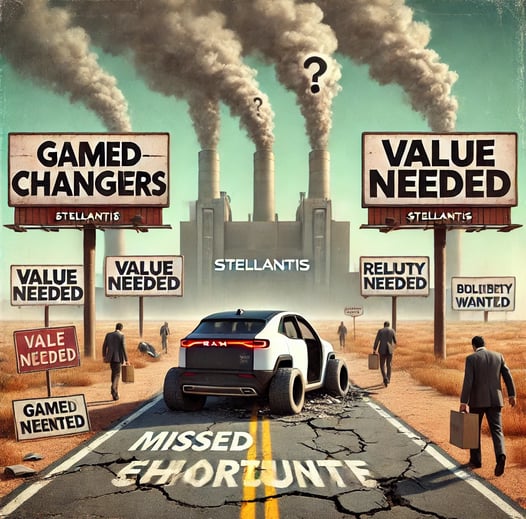Broken Promises and Missed Deadlines: Why Stellantis Can’t Keep Up in America’s EV Race
Chrysler—now Stellantis—has spent over 15 years making big EV promises and delivering nothing. From the failed ENVI program in 2008 to the latest delay of the Ram EV until 2025, it’s been a string of bad leadership, missed deadlines, and empty words. Meanwhile, American workers are losing jobs while the executives at the top keep cashing in. It’s a broken system, and Stellantis is running out of time to fix it.
Ladies and gentlemen, buckle up because we’re about to take a ride through the endless loop of failures that is Chrysler’s EV strategy. For over 15 years, this not-so-American Detroit Three brand has been playing a game of smoke and mirrors, hyping electric vehicles, shuffling leadership, and missing the mark every single time. If you’re wondering why Chrysler’s dealers are frustrated, why their workers are being laid off, and why their EVs are still stuck in neutral, the answer is simple: bad leadership, worse priorities, and a company that refuses to look in the mirror.
Now operating under Stellantis, the parent company formed from Chrysler’s merger with Fiat and PSA Group, this automaker continues its proud tradition of hyping EVs that never seem to make it to market. And with the most recent delay of their Ram EV pickup truck to 2025, it’s clear that the more things change, the more they stay the same.
2008: Chrysler’s EV Publicity Stunt
Let’s start at the beginning, back in 2008, when Chrysler launched its so-called ENVI division. Remember that one? They paraded flashy prototypes like the Dodge EV sports car, a plug-in hybrid Chrysler Town & Country minivan, and an extended-range Jeep Wrangler EV. Chrysler boldly promised these would hit the market by 2010. But here’s the truth: ENVI wasn’t a serious program. It was a publicity stunt, plain and simple.
At the time, Chrysler was flat broke, teetering on the edge of bankruptcy. The 2008 financial crisis had gutted the company, and they were desperately lobbying for federal bailout funds. What better way to look “innovative” than by rolling out a few EV prototypes and claiming they were ready to save the planet? But the reality? Chrysler didn’t have the money, infrastructure, or commitment to deliver. By 2009, the ENVI division was dead, and not a single one of those vehicles made it to production.
It’s a pattern that would repeat itself over and over again: bold EV promises, lots of hype, and absolutely no follow-through.
The Fiat Chrysler Era: EVs as an Afterthought
Fast forward to 2009, when Fiat stepped in to rescue Chrysler from bankruptcy. Under CEO Sergio Marchionne, Fiat Chrysler Automobiles (FCA) made it clear that electrification was not a priority. In fact, Marchionne was openly hostile to EVs, famously telling consumers not to buy the Fiat 500e because the company lost $14,000 on every sale. Let that sink in, folks: they built an electric car and then begged people not to buy it.
The 500e was a compliance car, built solely to meet California emissions regulations. It had a range of just 87 miles and was never marketed seriously. While competitors like Tesla, GM, and Nissan were making real progress with EVs, Fiat Chrysler was content to sit on the sidelines, churning out gas-powered Jeeps and Ram trucks while buying emissions credits from Tesla to stay compliant.
Even when FCA finally launched the Chrysler Pacifica Hybrid in 2017—a plug-in minivan that actually earned some praise—it was the exception, not the rule. FCA never built a broader EV lineup, leaving them years behind their competitors.
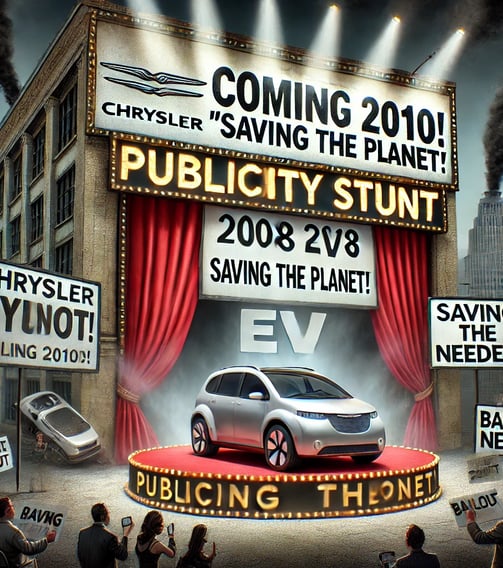

Stellantis: Same Problems, New Name
In 2021, Fiat Chrysler merged with PSA Group to form Stellantis, promising a bold new future and a serious commitment to electrification. The company pledged €30 billion toward EV development, with plans to launch 75 electric models by 2030. But two years in, what do they have to show for it? Not much.
The Ram EV pickup truck was supposed to be their big debut in the U.S. EV market. Originally slated for release in late 2024, it has now been delayed to 2025. CEO Carlos Tavares says they need more time to validate the product. Sure. That’s what they said about the ENVI prototypes back in 2008, too.
And let’s not forget the Ramcharger, an extended-range hybrid version of the Ram EV. It’s also delayed, with no clear timeline for release. In the meantime, Ford and GM are raking in sales with their electric pickups, and startups like Rivian are eating Stellantis’ lunch.
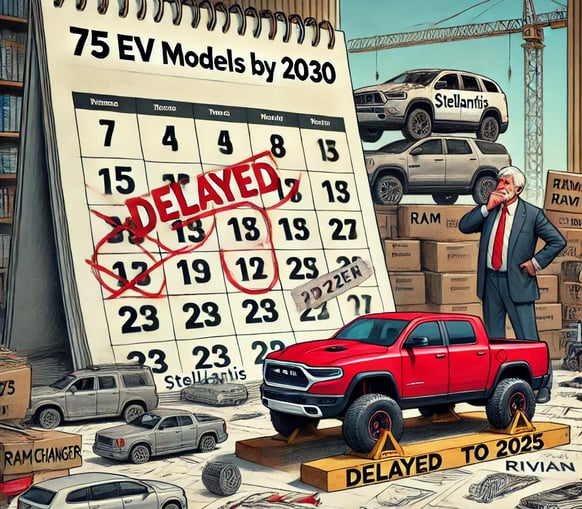

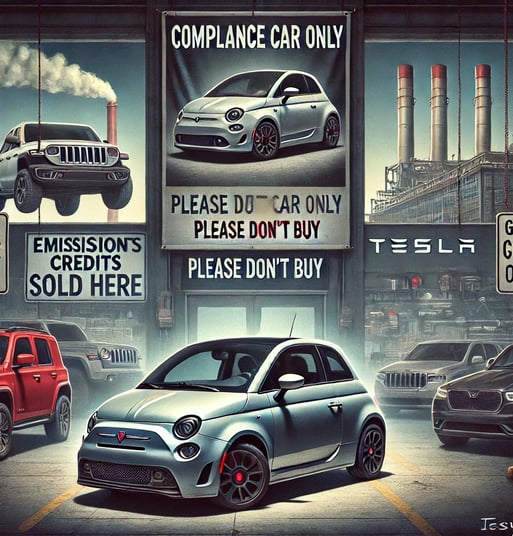

Leadership: A Revolving Door of Excuses
One of Stellantis’ biggest problems is its leadership—or lack thereof. Over the years, Chrysler, Fiat Chrysler, and now Stellantis have shuffled through CEOs and executives like it’s a game of musical chairs. Each new leader promises change, but none of them seem to understand the U.S. market or how to build an EV strategy that works.
Meanwhile, the company continues to lay off American workers. Stellantis recently announced 400 job cuts as part of its EV transition, even as they pay their executives seven-figure salaries. It’s a slap in the face to the workers and dealers who’ve kept the brand alive through decades of mismanagement.


EVs and the Economic Reality
The Ram brand was once a symbol of American strength and reliability. Ram trucks sold themselves because they were built for the working class. But today’s buyers, especially younger ones, are facing a much harsher reality.
Student loans are back, inflation is eating away at paychecks, and the cost of living has skyrocketed. For many, a $70,000 electric truck simply isn’t in the cards. Stellantis doesn’t seem to understand this. Instead of focusing on affordable, practical EVs, they’re hyping overpriced concepts that most buyers can’t afford and don’t trust.
And let’s talk about marketing, which has been another disaster. Stellantis is more interested in virtue signaling and DEI initiatives than actually selling cars. They’re trying to pander to coastal elites while ignoring the needs of middle America. Newsflash: woke slogans don’t sell trucks. Understanding your market does.
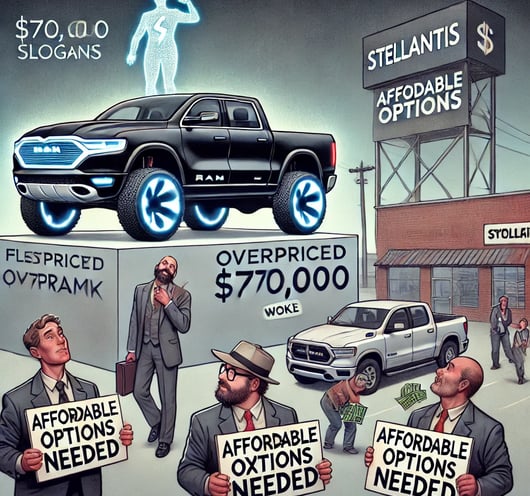

The Bottom Line: Stellantis Needs a Reality Check
Stellantis has spent over a decade hyping electric vehicles and delivering nothing. The Ram EV delay is just the latest in a long line of failures that stretch back to the ENVI days.
If Stellantis wants to survive, they need to stop the nonsense. Stop the empty promises. Stop the leadership shuffle. Stop hiring marketing teams that care more about agendas than buyers. Start hiring people who actually understand the market.
The American car buyer doesn’t want flashy concepts or overpriced gimmicks. They want value, reliability, and leadership they can trust. Stellantis isn’t delivering any of that, and until they do, they’ll continue to fall further behind.
The Ram EV could have been a game-changer. Instead, it’s just another chapter in Stellantis’ endless story of missed opportunities.
